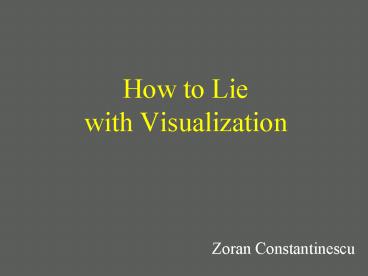How to Lie with Visualization - PowerPoint PPT Presentation
Title:
How to Lie with Visualization
Description:
How to Lie with Visualization Zoran Constantinescu references Al Globus et. al.; 14 Ways to Say Nothing with Scientific Visualization IEEE Computer, vol. 27, 1994 ... – PowerPoint PPT presentation
Number of Views:149
Avg rating:3.0/5.0
Title: How to Lie with Visualization
1
How to Liewith Visualization
- Zoran Constantinescu
2
references
- Al Globus et. al. 14 Ways to Say Nothing with
Scientific Visualization IEEE Computer, vol.
27, 1994 - Nahum Gershon Presenting Visual Information
Responsibly ACM Computer Graphics, vol. 33,
1999 - Nahum Gershon How to Lie and Confuse with
Visualization (VisLies) special sessions at
Siggraph and Visualization conferences
3
outline
- problem definition
- 14 ways to say nothing with SciViz
- examples
- conclusions
4
problem
- Seeing is believing.
- in synthetic imagery this is not always true
- (anybody can vis. anything in any shape/form)
- sources of imperfection
- imperfect presentation
5
imperfect presentation
- can prevent getting the information or reduce the
rate of absorption and understanding - or the user get perceive it wrongly
- data can be too complicated to comprehend
- visualization can misrepresent the information
6
14 ways to say nothing with SciViz
- it can be used to produce beautiful pictures
- usually we fail to appreciate the artistic
qualities of these images - scientists will use it to understand the data
- techniques to confound (confuse) such activities
7
1. never include a color legend
- many visualization techniques involve assigning
colors to scalar values - spoils the beauty of an image
- the viewer may be diverted into contemplation of
the reality
8
example
3D global view of Mars
9
example
3D global view of Mars
elevation
10
example
MRI scan of human head
11
2. avoid annotation
- used for pointing out features of interest
- used in combination with explanatory text
- promotes clarity of understanding
- undermines the sense of awe and confusion the
best scientific visualization engenders
12
example
H2O molecule
13
example
H2O molecule
electron density
14
3. never mention error
- visualization techniques might introduce error
- scientists might not be properly impressed if
mentioning error characteristics - never imply by word or deed that the technique
introduces any error - if the picture looks good, it must be correct
15
4. when in doubt, smooth
- smooth surfaces look much better than numerous
ugly facets - can also obscure errors and
- allow users to publish their results earlier
- always strive for the smoothest possible surface
- choose lighting normals to hide sharp edges
16
example
17
5. avoid providing performancedata
- it is completely irrelevant the time it took to
calculate the picture - e.g.. hours for ray-casting a isosurface, or
seconds using marching cubes - even if it takes longer, it is much smoother
18
6. use stop-frame animation
- each frame of a scientific video usually takes
from seconds to hours to produce - ? generate video frames one at a time
- then play back at high frame rates
- can dramatically improve perceived s/w perf.
19
example
each frame about 36 sec
20
7. never learn anything about data
- debugging is more difficult if worried about
producing correct results - complex accurate interpolation techniques
- ad-hoc techniques produce prettier pictures
- programming bugs can produce stunning images
21
8. never compare results
- with other visualization techniques
- may detect bugs to be fixed
- other techniques may produce prettier pictures
22
example1
view dependent rendering of terrain data set
23
example2
flat map view of Mars
3D global view of Mars
24
9. avoid visualization systems
- provide mechanisms to add new modules
- users may violate rule 8 (never compare)
- usually not invented here
- (so we dont use them )
25
10. never cite references for data
- dont cite reference describing the data used
- someone may read the paper
- and discover the visualization bears no
relationship to the original experiment - will divert attention from the pictures appeal
26
11. claim generality
- but show results from a single data set
- difficult to write vis. algorithms to work
properly on a variety of data - much effort can be saved, if
- run on one data, then make the image look
different, as if from other datasets - and use rule 10 (never cite refs)
27
12. use viewing angle to hide imperfections
- many vis. algorithms produce 3D objects
containing unpleasant imperfections - avoid viewing angles exposing them
- if not, try another data set
- or
28
13. use specularity or shadows
- specular reflectionreflection from a smooth
surface (mirror) maintaining the incident wave - use shadows or brilliant highlights to hide the
unpleasant 3D imperfections
29
14. this is easily extended to 3D
- 3D algorithms much more difficult than 2D
- the effort of generalizing a 2D alg. can detract
from producing pretty pictures - simply claim that the algorithm is easily
extended to three ore more dimensions
30
conclusions
- details some techniques to divert attention away
from data and towards beauty, - (audiences love color graphics and animations)
- and to avoid tedious debugging of software
- to lie or not to lie?
- variations in the method ? influence the users
perception and interpretation of data
31
- end -
- http//www.idi.ntnu.no/zoran































